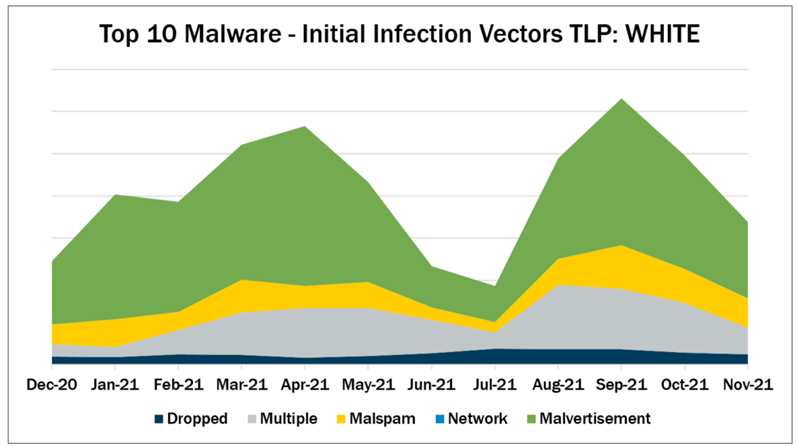Top 10 Malware December 2021
![]()


In December 2021, malvertisement accounted for the greatest number of alerts. Malvertisement continues as the top initial infection vector due to Shlayer activity. Activity levels for all initial infection vectors decreased. Shlayer and CoinMiner remain in the top two spots. The activity from these malware is primarily from the education sector. Shlayer is a downloader and dropper for MacOS malware. It is primarily distributed through malicious websites, hijacked domains, and malvertizing posing as a fake Adobe Flash updater. CoinMiner is a cryptocurrency miner that uses Windows Management Instrumentation (WMI) and EternalBlue to spread across a network. CoinMiner uses the WMI Standard Event Consumer scripting to execute scripts for persistence. CoinMiner spreads through malspam or is dropped by other malware.

Dropped – Malware delivered by other malware already on the system, an exploit kit, infected third-party software, or manually by a cyber threat actor. Gh0st, Mirai, and Qakbot the malware utilizing this technique.
Multiple – Malware that currently favors at least two vectors. Currently, CoinMiner, RedLine, and ZeuS are the malware utilizing multiple vectors.
Malspam – Unsolicited emails, which either direct users to malicious web sites or trick users into downloading or opening malware. Top 10 Malware using this technique Agent Tesla, Cerber, and NanoCore.
Malvertisement – Malware introduced through malicious advertisements. Currently, Shlayer is the only Top 10 Malware using this technique.
Top 10 Malware and IOCs
Below are the Top 10 Malware ranked in order of prevalence. The respective indicators of compromise (IOCs) are provided to aid in detecting and preventing infections from these Top 10 Malware variants. Note: The associated URIs are aligned with malware’s respective domain(s) or IP(s) and increase the likelihood of maliciousness when found together. The URIs alone are not inherently malicious.
1. Shlayer
Shlayer is a downloader and dropper for MacOS malware. It is primarily distributed through malicious websites, hijacked domains, and malvertizing posing as a fake Adobe Flash updater.
All Shlayer domains follow the same pattern <api.random_name.com>. Below area several examples of domains Shlayer uses.
Domains
- api[.]interfacecache[.]com
- api[.]scalableunit[.]com
- api[.]typicalconfig[.]com
- api[.]standartanalog[.]com
- api[.]fieldenumerator[.]com
- api[.]practicalsprint[.]com
- api[.]searchwebsvc[.]com
- api[.]connectedtask[.]com
- api[.]navigationbuffer[.]com
- api[.]windowtask[.]com
2. CoinMiner
CoinMiner is a cryptocurrency miner that uses Windows Management Instrumentation (WMI) and EternalBlue to spread across a network. CoinMiner uses the WMI Standard Event Consumer scripting to execute scripts for persistence. CoinMiner spreads through malspam or is dropped by other malware.
3. ZeuS
ZeuS is a modular banking trojan which uses keystroke logging to compromise victim credentials when the user visits a banking website. Since the release of the ZeuS source code in 2011, many other malware variants have adopted parts of its codebase, which means that events classified as ZeuS may actually be other malware using parts of the ZeuS code.
4. NanoCore
NanoCore is a RAT spread via malspam as a malicious Excel XLS spreadsheet. As a RAT, NanoCore can accept commands to download and execute files, visit websites, and add registry keys for persistence.
5. Agent Tesla
Agent Tesla is a RAT that exfiltrate credentials, log keystrokes, and capture screenshots from an infected computer.
6. Gh0st
Gh0st is a RAT used to control infected endpoints. Gh0st is dropped by other malware to create a backdoor into a device that allows an attacker to fully control the infected device.
7. Mirai
Mirai is a malware botnet known to compromise Internet of Things (IoT) devices in order to conduct large-scale DDoS attacks. Mirai is dropped after an exploit has allowed the attacker to gain access to a machine.
8. Cerber
Cerber is an evasive ransomware that is capable of encrypting files in offline mode and is known for fully renaming files and appending them with a random extension. There are currently six versions of Cerber, which evolved specifically to evade detection by machine learning algorithms. Currently, version 1 is the only version of Cerber for which a decryptor tool is available.
9. Qakbot
Qakbot is financial malware designed to target governments and businesses for financial fraud and known for its wormability on a network. Qakbot installs a keylogger to steal user credentials. It monitors network traffic, specifically traffic to online banking websites and can piggyback on a user’s active banking session by intercepting authentication tokens.
10. RedLine
RedLine, is an infostealer available for purchase on cyber-criminal forums. Campaigns, targets, infection vectors and capabilities vary based on the version purchased. The malware typically targets information that can be easily monetized, such as credentials, cookies, banking information, and cryptocurrency wallet information. Additionally, the malware gathers information about the infected system such as web-browser, FTP clients, instant messengers, VPN services, and gaming clients. Furthermore, RedLine has remote functionality allowing it to download further malicious tools or drop additional malware.
As of June 23, 2025, the MS-ISAC has introduced a fee-based membership. Any potential reference to no-cost MS-ISAC services no longer applies.